26 key video lessons on business and personal growth you should see today
Take the reins of your personal and professional growth with 26 video lessons from global business thinkers speaking at BRAND MINDS 2023.

Video lessons on PERSONAL GROWTH with JAMES CLEAR, Bestselling Author of ‘Atomic Habits’
1. How to trigger good habits automatically
2. How long does it take to form a new habit
3. How to get 40 times better at anything
4. Building and changing habits
Video lessons on DIGITAL MARKETING STRATEGY with NEIL PATEL, Digital Marketing Expert
5. How to build a marketing strategy in 10 minutes
6. Seven underrated marketing tips
7. Key lessons learned from hiring a CEO
8. Unique marketing lessons from billion-dollar companies you’ve never heard of
9. Four digital marketing strategies that just work
Video lessons on HOW IS FUTURE OF WORK IMPACTING YOUR COMPANY with LYNDA GRATTON, Future of Work Strategy Expert @London Business School
10. The 2 key factors redesigning today’s workplace
11. Redesigning work
Video lessons on the GLOBAL ECONOMY with NASSIM NICHOLAS TALEB, Author & Risk Analyst
12. What are the greatest risks facing the global economy
13. Why ‘Skin in the Game’ is necessary to make sense of the world at large
Video lessons on BUSINESS GROWTH STRATEGY with Renée Mauborgne, Bestselling Author of Blue Ocean Strategy & Blue Ocean Shift
14. How to find new business growth opportunities in 3 essential steps
15. How to create exceptional business growth through the Blue Ocean Strategy
Video lessons on INNOVATION & CREATIVITY with DUNCAN WARDLE, Innovation Expert & Creative Director of Disney
16. What is a simple way to get new ideas
17. How to challenge people to develop remarkable ideas
18. What is the Moon Shot Thinking and what rules you should be challenging to get to it
19. How to get into the right state of mind to innovate at work
20. How to solve your business challenge by looking around the world of innovation
Video lessons on SALES STRATEGY SECRETS with Blair Singer, World Famous Sales Expert
21. Three secrets to winning every sales pitch
22. Six things that will give you an instant advantage in front of everyone
23. How to start your journey to a scalable business
24. How to build the dream team in the business
Video lessons on ARTIFICIAL INTELLIGENCE AND THE FUTURE OF WORK with ANNE-MARIE IMAFIDON, Tech Leadership Expert
25. Why leaders should adopt A.I. to future-proof their businesses
26. The definitive guide to changing your company from the inside out
BRAND MINDS: 30 top reasons to bring your team
BRAND MINDS is among the Top 5 largest business conferences in Europe providing its attendees with a unique business edutainment experience.

More than 6000 professionals from 500 companies in 80 countries attended BRAND MINDS on June 2nd and 3rd, 2023.
Bring your team to BRAND MINDS because teams who learn together will grow the company together.
30 reasons to bring your team to BRAND MINDS
You and your team will:
#1 Learn business strategy from the most respected business experts in the world;
#2 Access the opportunity to interact with +7000 business specialists from over 50 countries;
#3 Reconnect with business partners from +11 industries;
#4 Learn how to create an organizational culture where people develop exponentially;
#5 Discover the latest trends in design thinking & innovation;
#6 Discover new models of leadership & team management;
#7 Discover the latest trends in professional development;
#8 Enjoy the most memorable teambuilding yet;
#9 Connect with the latest trends in technology & artificial intelligence;
#10 Learn tactics to overcome any sales objection;
#11 Learn to build an effective digital marketing strategy for your company.
#12 Learn new techniques to develop healthy habits that will help you achieve your vision;
#13 Learn techniques to amplify autonomy & innovation in your team;
#14 Enjoy a complex learning experience, equal to reading 8 books in a day;
#15 Leave with at least 3 actionable ideas to scale up your company;
#16 Discover 8 habits that amplify creativity in a team;
#17 Learn the most effective risk management strategies;
#18 Learn to develop a high-performing sales team;
#19 Learn the latest tactics in sales strategy to close big clients;
#20 Access the opportunity to build new business partnerships;
#21 Network with decision-makers from +300 Top companies;
#22 Discover global economic trends that will help you adapt your business strategy for the future;
#23 Learn team engagement techniques through design thinking;
#24 Learn how to achieve the most ambitious career goals without facing burnout;
#25 Discover artificial intelligence tools that will help your company adapt for the future;
#26 Learn the most common mistakes leaders make that result in team demotivation;
#27 Learn the latest strategies and frameworks of customer loyalization through digital marketing;
#28 Leave with the BRAND MINDS World-Changer participation certificate;
#29 Meet authors among the most respected internationally in a live, in-person event;
#30 Access the opportunity to interact with some of the most renowned business experts of the moment.
3 best creative advertising campaigns of 2022
McEnroe vs McEnroe for Michelob ULTRA – It’s only worth it when you enjoy it
John McEnroe is one of the world’s all-time best tennis players. Very talented and hard-working, John was famous for his intense playing style and confrontational disposition which earned him the nickname Superbrat. During his 18-year career, he won many championships, but he didn’t seem to enjoy playing tennis. Now a retired professional athlete, does John still feels the same about playing tennis? Light lager beer brand Michelob ULTRA, whose brand message is It’s only worth it if you enjoy it, reached out to John McEnroe and invited him to share his thoughts on his life and career from a fresh perspective in a very special campaign with the help of high technology.
Brand: Michelob UTRA & ESPN
Campaign type: Sports event
Awards: 5x Cannes Lions, 1x FWA
Results:
10 million views across ESPN’s channels
Viewership overtook the 2021 NBA finals, making it the year’s most-watched sports event
Tip to spark your creativity: Find a powerful insight related to your customer that is in line with your brand value and message; find an innovative way to present it to your audience by using the technology available to you.
Trapped in the 90s for IKEA Spain
They say you don’t appreciate the things you have until they are taken away. Are you a morning person? You couldn’t imagine your life without your espresso machine which makes the best cappuccinos in the world. Or your healthy veggie shake which you make at home, on your easy-to-use blender. You grab it before heading to the office and puts a smile on your face. Brands are part of our lives and give us pleasure and comfort. What would your life be without them? That’s what IKEA Spain wanted to find out in celebration of 25 years since the brand’s arrival in the country.
The year IKEA came to Spain is the year a new generation was born, Gen Z. The Gen Zers grew up with the level of comfort and design provided by IKEA products. What if we showed them what was life like in the 90s before IKEA? And that’s exactly what the creative team behind Trapped in the 90s did. They picked six Gen Zers or IKEA natives, as they named them, and invited them to participate in a reality show where they have to “survive a house with an explosive stove, heavy itchy blankets, rotary phones, smoky mirrors, and dim lights…” The goal of the campaign was to showcase the iconic brand’s impact on people’s daily lives. The participants who won the challenges prepared for them by the IKEA team were given IKEA products making their lives a bit more comfortable.
Brand: IKEA Spain
Campaign type: Reality Show
Awards: 2x Cannes Lions
Results:
169% increase in deliveries
Time spent on the IKEA Spain website – from 2 minutes to 18 minutes
+1.8 million minutes of content watched
1400% more interactions on social media
Over 1.5 million euros worth of new products were sold in the first-week
Tip to spark your creativity: Help your customers see what their life would be like without your brand
Under Armour: The First Meta Sneaker
Whether it’s Second Life, GTA, Minecraft or The Sandbox, virtual world games are all the rage right now with millions of people playing them. The Metaverse has been a hot topic for the past two years and things got more serious when brands joined the conversation. BMW, Gucci, Nike, Disney and Coca-Cola are just a few examples of brands using the Metaverse and creating events inside established virtual worlds like Roblox or Decentraland. The problem with multiple metaverses is that you cannot take your assets from one world to the other. That’s a problem that Under Armour solved by building Genesis Curry Flow, the first wearable NFT with the ability to move between virtual worlds.
Brand: Under Armour
Campaign Type: NFT collection
Awards: 1x Cannes Lions
Results:
The NFT collection sold out
Raised 1 million US dollars for charity in just 10 minutes
Tip to spark your creativity: Solve your customer’s problem in an innovative way
What are the 4 types of innovation?
Innovation – the #1 soft skill companies are looking for
Last year, the World Economic Forum in collaboration with LinkedIn released its 2025 Future of Jobs report.
This report maps the jobs and skills in the next five years.
As you can see below, innovation ranks at #1 in the Top 10 skills employers are looking for in an employee in 2025.
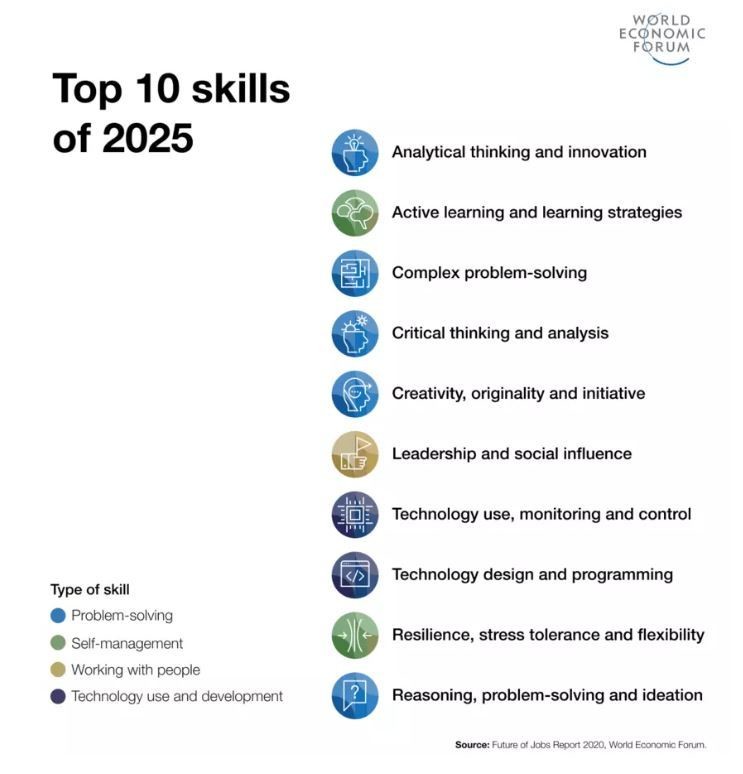
In 2020, the top most sought-after skill was creativity.
Why are employees expected to have analytical thinking and innovation skills? Why is creativity not enough?
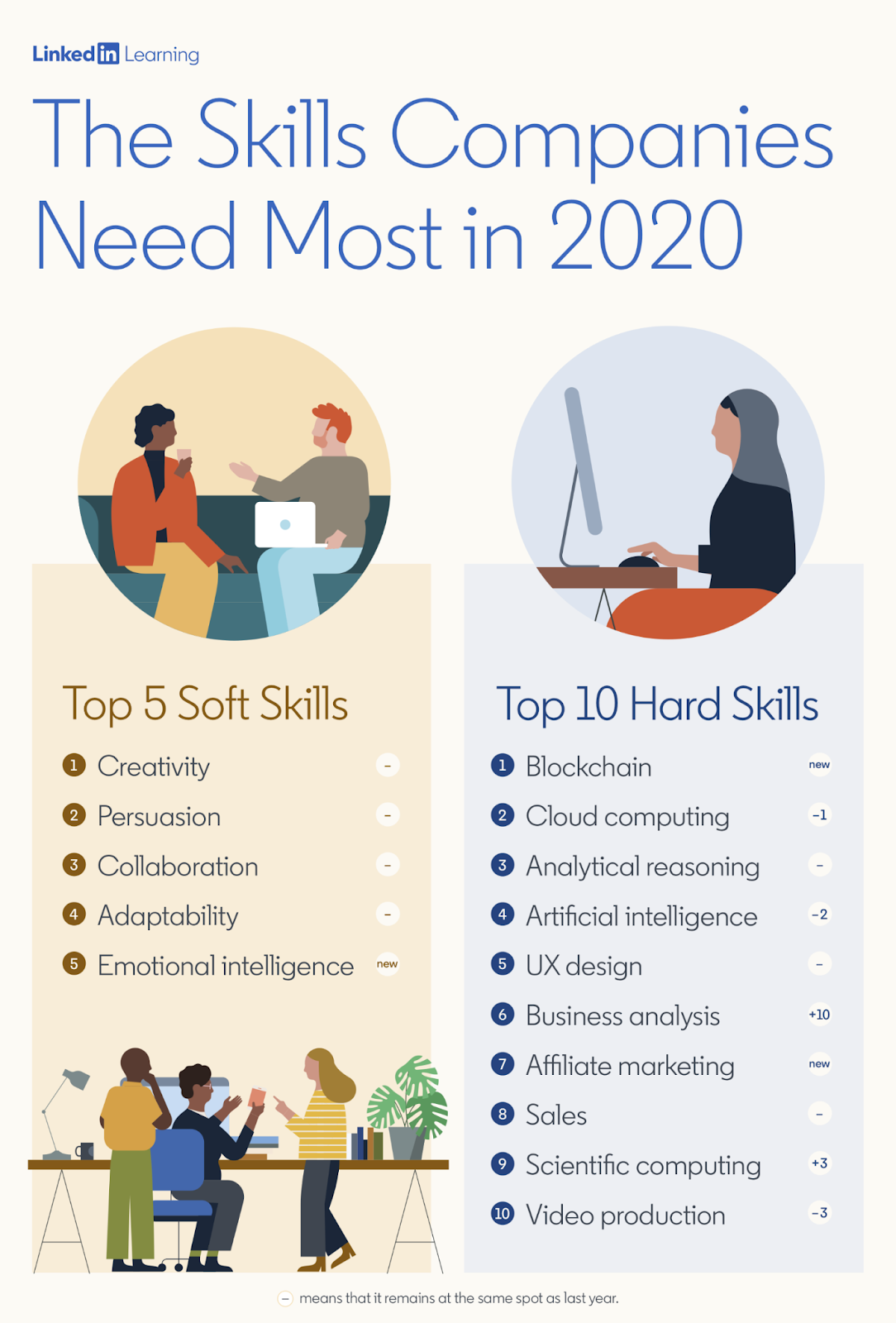
The World Economic Forum report answers this question with an in-depth list of key insights which I encourage you to read.
But if you want the short answer, here’s my conclusion.
The future of work is about automation and robots. The report found that by 2025, the time spent on current tasks at work by humans and machines will be equal.
While an AI software can do creative work (see the AI writing news or the AI doing movie trailers), software and automation robots cannot be innovative.
Innovation requires other skills besides creativity. Read on to find out what these skills are.
If innovation is not (only) creativity, then what is it? Is it a process? Is it a mindset?
First let’s establish the difference between creativity and innovation.
Creativity vs Innovation
On this subject, the best definition of innovation as opposed to creativity I could find is the following:
The key difference between creativity and innovation is that the first refers to generating a fresh and new idea, whereas the second implies initiating new service, product or invention to the market, which was not introduced before.
Creativity vs Invention vs Innovation
Let’s bring another term into the conversation, one that is commonly used to define innovation: invention.
Does invention equals innovation? And if it doesn’t, what’s the difference between invention and innovation?
To answer this question, here’s a great piece of content from Innoway, an innovation consultancy:

They do a great job of explaining the difference between creativity, invention and innovation.
Creativity is the art of turning new and imaginative ideas into reality.
Invention is the creation of a new idea or concept.
Innovation is turning a new concept into commercial success or widespread use.
Zaha Hadid’s amazing buildings are a testament to her creativity, but they are neither inventions, nor innovations.
Leonardo da Vinci, the famous painter was also a prolific inventor. Among his many designs was that of a helicopter which he called the Aerial Screw.

Leonardo da Vinci’s helicopter
If you look at da Vinci’s sketch dating back to the 1480s, you will notice a very strong resemblance with NASA’s Ingenuity Helicopter which took its first flight on Mars earlier this month.

Ingenuity helicopter, source: NASA
Taking inspiration from Leonardo’s concept, the engineers at NASA were prompted to solve a series of challenges related to Mars’ atmosphere. The Red Planet’s atmosphere is 99% less dense than Earth’s which makes it difficult for the helicopter to achieve enough lift.
The Aerial Screw is an invention while the Ingenuity is an innovation.
What is innovation?
Innovation sits at the intersection of customer desires, technology and business opportunities.
Innovation is defined as something new to the market that creates economic and customer value through research, creativity and invention.
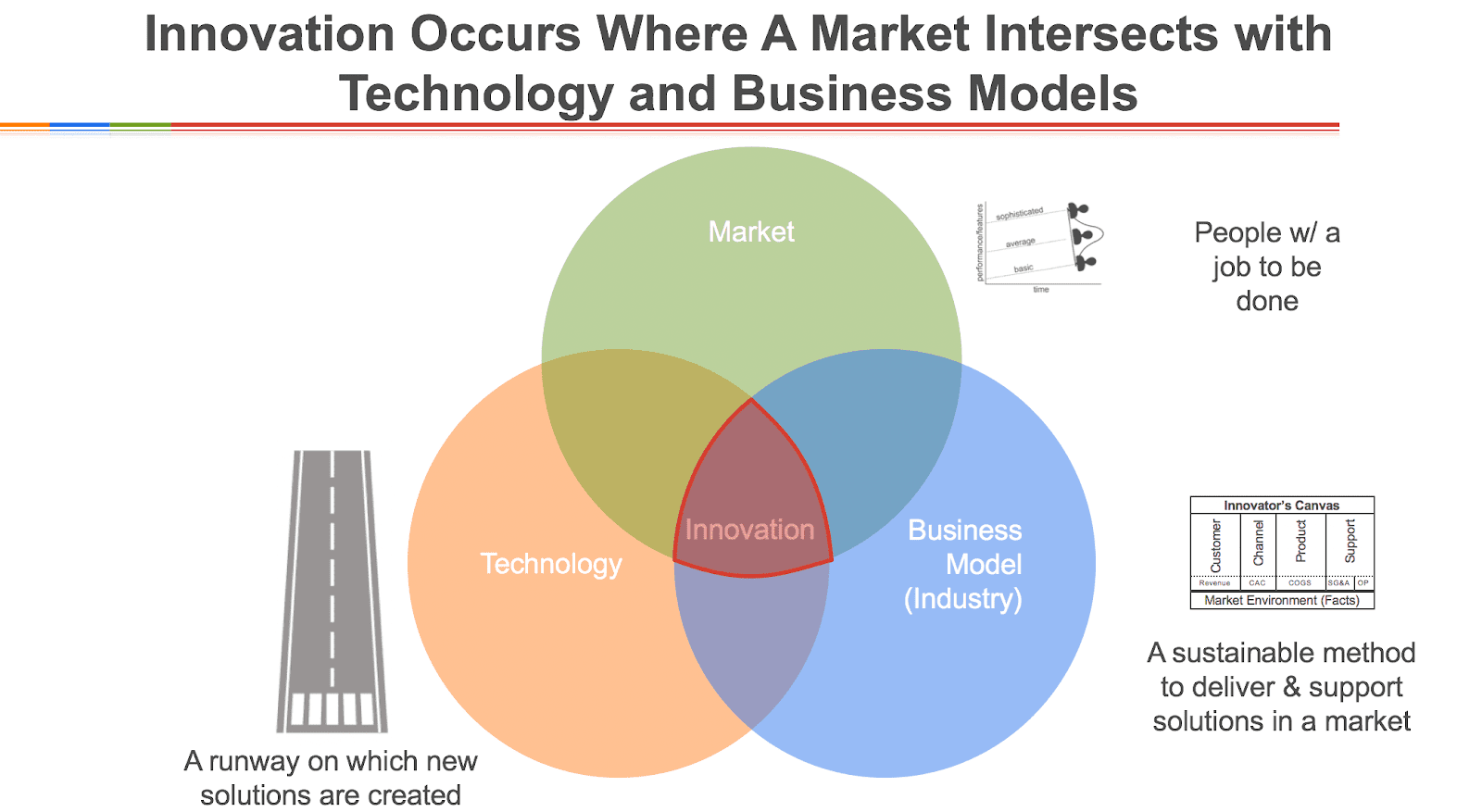
source: ignitionframework.com
Innovation occurs where a market intersects with technology and business models.
The market is composed of people with a job to be done. The business model is a sustainable method to deliver and support solutions in a market. Technology is a runway on which new solutions are created.
Innovators start with the market in mind and what the customers want or need.
Technology is not a goal, it’s a means to an end. Innovators ask themselves How can I use technology to address an unmet need in the market? What technology-driven solution can I come up with that provides customers with a solution to their problems and revenue for the company?
This is what innovators think about when they wake up in the morning and when they go to sleep at night.
The 4 types of innovation

Jake Nielson, a marketing leader with 10+ years of innovation management experience came to the conclusion that there are 4 types of innovation:
- sustaining innovation;
- disruptive innovation;
- new market innovation;
- integrative innovation.
Sustaining innovation
Apple is an example of sustaining innovation. Since the first iPhone in 2007, the company has come up with new iterations of the iPhone every year. Every iteration had new features, improved functionality, beautiful design and innovations.
Disruptive innovation
Airbnb disrupted the hospitality industry. Uber disrupted the taxi industry. Netflix disrupted the DVD mail service. Amazon disrupted brick and mortar commerce. All four provide a better alternative enabled by new technology.
New market innovation
BMW has been manufacturing conventional cars since the early 1950s. Starting with the 1970s, the German car maker has been researching and testing electric cars. Today BMW electric cars are among the best in the market and the company is planning to offer plug-in hybrid versions of all its core-brand models.
Integrative innovation
MailChimp started out as an email provider for small businesses. The company’s email service was so successful that it became one of the most popular in the world. Listening to their customers’ needs, MailChimp expanded its services. MailChimp is now more than an email service provider, it’s an all-in-one marketing platform which empowers its users to build landing pages, create digital campaigns and leverage powerful insights. It supports small businesses to reach their marketing goals faster.
What type of innovation is your company developing?
Join the Conversation
We’d love to hear what you have to say.
Get in touch with us on our LinkedIn Page, Facebook Page, Twitter or TikTok.
Top 5 most in-demand soft skills you need to grow in 2021
Looking to develop your soft skills? Read on to discover the Top 5 most in-demand soft skills you need to grow in 2021.
Professional growth and career advancement hinge on the employee’s desire and ability to learn new things.
Whether you are looking to specialize in your field which means you’d want to go deep, or you are looking to diversify which implies going left and right (learn more about the T-shaped marketer), learning never stops. And it shouldn’t, rightfully so.
Over the past few years, LinkedIn, the 722-million member professional social platform, has been curating a list of the most in-demand soft and hard skills employers are looking for.
Here is LinkedIn’s list for the most in-demand soft and hard skills 2020.
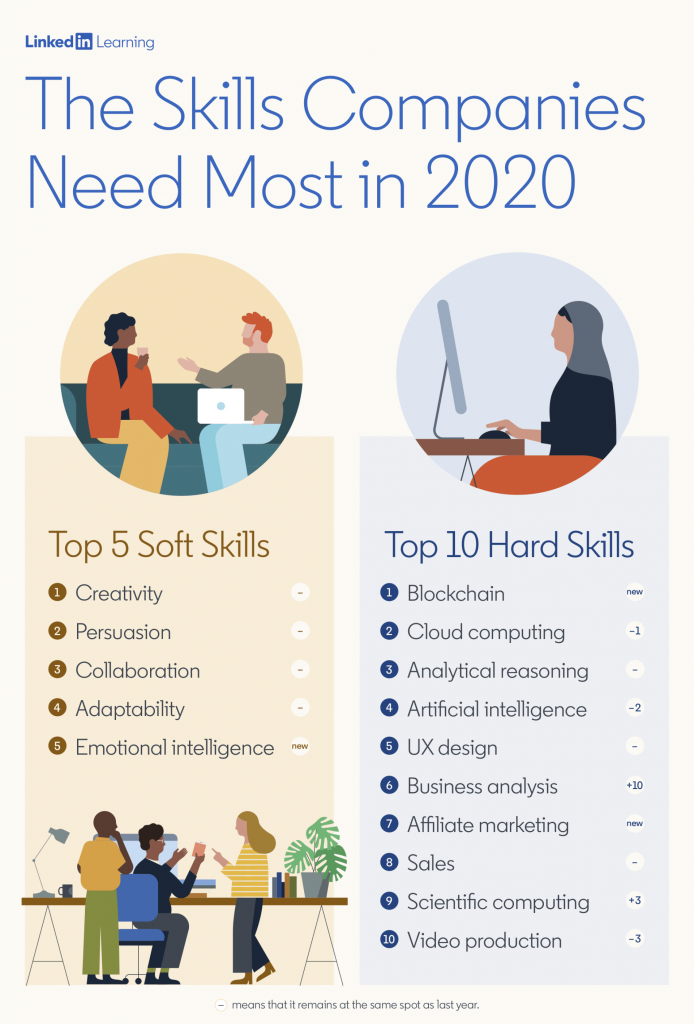
What are the Top 5 soft skills companies look for in their employees and new hires in 2020?
- Creativity
- Persuasion
- Collaboration
- Adaptability
- Emotional intelligence
Let’s talk about each of them.
1. CREATIVITY
Creativity is now the #1 soft skill companies are looking for three years in a row.
Why is creativity in such high-demand?
Listen to creativity expert and BRAND MINDS speaker Denise Jacobs:
Can creativity be taught or is it an inherent trait?
I believe one of the most creative organizations in the world today is NASA. Going into space requires finding solutions to unique problems and even unknown situations. That certainly pushes the brightest minds at NASA to come up with creative and out-of-the-box solutions.
In the 1960s, NASA reached out to Dr George Land, a creative performance researcher and enrolled his expertise in devising a creativity test to help with the selection for innovative engineers and scientists. Dr Land accepted the challenge and devised a creativity assessment that worked very well.
Inspired by the results and curious to know more about where creativity comes from, Dr Land conducted a research study to test the creativity of 1,600 children ranging in ages from 3 to 5 years old. He re-tested the same children at 10 years of age, and again at 15 years of age. And then he extended the testing pool to include 1 million adults.
What exactly did Dr Land test for?
He tested for the ability to look at a problem and come up with new, different and innovative ideas.
Here are the results:
5-year-olds: 98% imaginative
10-year-olds: 30% imaginative
15-year-olds: 12% imaginative
31-year-olds: 2% imaginative
That’s quite a shock, isn’t it?
We are the most creative in our childhood and we lose our creativity growing up.
What is the reason?
Dr Land gave the following explanation in his book, Breaking point and beyond:
What we have concluded is that non-creative behaviour is learned.
Is there something we can do about it?
In his 2016 Tedx Talk, Dr Land says there is a way to undo this process.
Let’s hear from Dr Land (08:37):
First of all, we need to think about creativity beyond artistic abilities.
Artists are not the only creative people.
Professionals in every industry have the ability to be creative. Because in the workplace, being creative means looking at a problem from a different viewpoint and coming up with a fresh solution, as Dr Land explained a few years ago.
It’s not about waiting to be inspired; it’s about thinking creatively.
According to Martin Lindstrom, brand expert and BRAND MINDS speaker, the first step towards creativity is taking time off from your smartphone, observing the people around you and essentially allowing yourself to be present.
2. PERSUASION
In business communication, persuasion is the process of presenting arguments to move, motivate, or change your audience.
Persuasion is one of the most important skills that a leader needs. He has the vision and he sets the goal; he needs to move and motivate his employees to fulfil the vision and meet the goal.
It’s the leader who tells his colleagues Come with me and let’s accomplish the mission together. This is the authoritative leader who provides employees with inspiration, motivation, empowerment and a sense of accomplishment.
Or the visionary leader whose motto is Embrace my vision. This type of leadership is called visionary leadership. The visionary leader must hone his persuasion skills to inspire and motivate people to pursue a long-term vision. Learn more about leadership styles: 12 Leadership Styles for Successful Leaders (complete list) with Pros & Cons.
Persuasion skills are necessary for sales and marketing as well. With a 30-year career researching the science of influence, Dr Robert Cialdini is the world’s most renowned persuasion expert and a BRAND MINDS speaker.
His Theory of Influence is based on seven key principles:
- Reciprocity,
- Commitment and consistency,
- Social proof,
- Authority,
- Liking,
- Scarcity,
- Unity.
Brands build on them to increase brand awareness and sales. Dr Cialdini’s latest insights on persuasion are in his 2016 book Pre-Suasion: A Revolutionary Way to Influence and Persuade.
3. COLLABORATION
We are living and working in a fast-paced environment.
Startups with a handful of employees that work as one are able to move quickly and more efficiently. Corporations with thousands of employees are slow and bureaucratic.
There are many examples of hundred-year-old brands outcompeted by new entrants on the market.
That’s where agility comes into play as a way of organizational transformation with one goal: adapt.
Want to learn more about agility? Read 22 benefits of the agile organization.
For an organization to become agile, its employees must form small teams. Every team member is expected to collaborate with each other. And that’s more difficult than you might think.
To meet the set goals, team members must learn to listen to each other, be supportive, be generous, learn to communicate clearly and openly, share knowledge and information, refrain from judgement, reject bias, debate and adapt.
The team leader must also be an example of effective communication and collaboration.
4. ADAPTABILITY
At the time of writing, the world has been fighting to end the COVID-19 pandemic for almost a year.
Our private and professional lives have been profoundly affected.
Many businesses are fighting to survive while others have already closed their doors. Adaptability has never been more important.
Why are companies looking for employees with a high ability to adapt?
Because these employees are a great asset to the company.
Highly-adaptable employees are:
- Willing to experiment;
- Undeterred by failure;
- Use the failure as an opportunity to learn;
- Resourceful;
- Keep an open mind;
- Have a growth mindset.
5. EMOTIONAL INTELLIGENCE
Emotional intelligence is a new entry in LinkedIn’s Top 5 most in-demand skills of 2020.
Why are companies looking for emotional intelligent employees?
Let’s first find out what is emotional intelligence.
Emotional intelligence is the ability to perceive, evaluate, and respond to your own emotions and the emotions of others. It’s the skill that facilitates and nurtures the other four.
Daniel Goleman, one of the world’s leading psychologists and BRAND MINDS speaker, introduced the concept of EQ or emotional intelligence in his 1995 bestseller, Emotional Intelligence.
According to Daniel Goleman, there are 5 key elements of emotional intelligence:
- Self-awareness;
- Self-regulation;
- Motivation;
- Empathy;
- Social skills.
Employees with high EQ collaborate better, are more adaptable, use persuasion for the right reasons, are motivated and able to motivate others.
The workplace benefits from increased engagement and the business are more likely to find creative ways to stay ahead of the competition.
Join the Conversation
We’d love to hear what you have to say.
Get in touch with us on our LinkedIn Page, Facebook Page, Twitter or TikTok.
Co-Working Spaces and Their Role In Boosting Creativity For Small Businesses
As shown at the Global Coworking Unconference Conference forecast, by 2022 there will be 30,432 spaces and 5.1 million paid co-working members worldwide. The market shows an average annual growth rate of 24.2 percent since 2007, and is less a way of working now than a way of life. At the same time, the self-employed knowledge worker sector is growing too, bringing with it the need for hubs to provide social interaction, alternative locations than the cramped office desk or coffee shop, and clusters of interaction for connectivity.
It’s really easy to see that for startups and small businesses, the co-working solution ticks all the boxes of flexible, affordable space, and a creative hub to foster new ideas and new business.
According to Deskmag’s annual Global Coworking Survey, 71 percent of participants reported a boost in creativity since joining a co-working space, while 62 percent said their standard of work had improved. The study also found that half of all co-workers access their work space around the clock–with only 30 percent preferring to work during normal business hours. “The future of work should not be dictated by space or place, but by the individual and the tasks that he or she has to deliver,” Regus CEO Mark Dixon told Fast Company.
Moreover, an overwhelming majority (90 percent) of co-workers said they got a self-confidence boost, likely due to the fact that many spaces are filled with supportive communities that enable creative collaboration.

There is no doubt that co-working office spaces are the future of the business world. Having the option to consult with and share ideas with other like minded business owners and freelancers gives you the chance to bring different ideas and opinions into how you do your work and could expand your business more than you ever dreamed. At the same time, networking is made possible like never before. There is no better way to expand your inner circle than to be working closely with hardworking, determined individuals who all desire a common goal. Collaborations with future employees may take your business to a level you never thought possible.
The co-working model also generates a creative economy made up of individuals who not only need an inexpensive way to operate, but need a consistent flow of new people, new ideas, and new opportunities. Without this type of engagement, creatives are forced to seek employment elsewhere, such as with a corporation, and this limits their ability to engage with other local businesses that could benefit from top-tier talent on a small-business scale. But being together in the same place can translate in beautiful-shared ideas and new concepts coming to life. And,why not, new business opportunities.
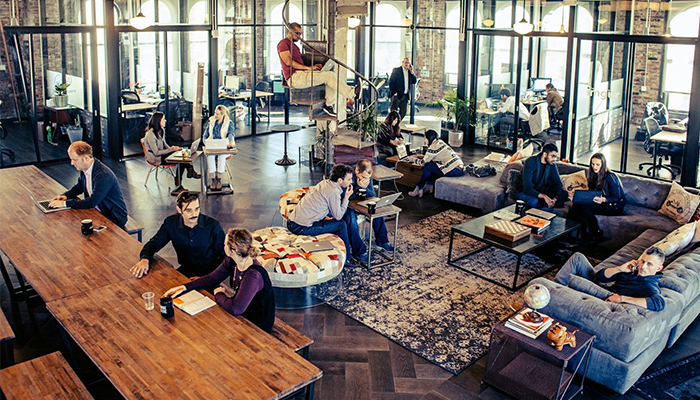
Local business like restaurants,coffee shops, galleries, can also benefit from co-working spaces through direct programming, partnerships, and access to pools of available, independent contractors in industries like interior design or legal services.
Working amidst people doing different kinds of work can also make one’s own work identity stronger. Our respondents were given the opportunity to frequently describe what they do, which can make what they do seem more interesting and distinctive. (….) the variety of workers in the space means that co-workers have unique skill sets that they can provide to other community members.- hbr.org.
8 tips and tricks to stimulate your creativity

Are you feeling less creative than usual?
Creativity blockage can make you feel frustrated and powerless and it really takes a toll on your self-esteem.
If you are feeling stuck, follow our list of 8 tips and tricks to stimulate your creativity:
1.disconnect
It’s not easy to take a break nowadays: we spend almost 4 hours on our smartphones or other devices connected to the internet.
Most of our time connected to the internet is spent browsing on social media, watching YouTube videos or following the latest news and gossip. We are totally hooked!
If you feel your creativity has dried up, you need to cut yourself from all sources of noise and mind clutter. You need to push the stop button and allow your mind to relax and unwind.
Disconnect your smartphone from the internet and put it away.
Take a break from your busy life and go away for a few days.
Book a short vacation over the weekend.
Allow your mind and soul to breathe in with no pressure.
2. indulge in your hobby
What’s your passion? Do you like handcrafting? Or do you like to cook for your friends and family?
Find time to dedicate yourself to whatever activity makes you feel good and relaxed. Hobbies bring a sense of fun and freedom to life that can help minimize the impact of stress or pressure. Hobbies can enhance your creativity, help you think more clearly and sharpen your focus.
Psychiatrists say that making time for enjoyable activities stimulates parts of the brain associated with creative and positive thinking and we become emotionally and intellectually more motivated.
3. allow yourself to sleep
Do you get enough night’s rest?
The recommended amount of sleep is eight hours a day. But sometimes we cannot get enough sleep because we work late at night to meet deadlines, or we stay awake because we worry about our future etc. Sleep is overrated!, you might say. But you couldn’t be more wrong!
Scientists have discovered why sleep is so important for us – it helps clear the mind of the day’s chemical clutter. Latest research found that unlike the rest of the body, which depends on the lymphatic system to drain away toxins, the brain has its own separate method of rubbish removal – sleep.
So allow yourself to sleep and get your creativity juices flowing.
4. expose yourself to art
Art – in its many forms and expressions, is the ultimate representation of man’s creativity. From classical to contemporary, art is about life, beauty and truth.
Expose yourself to art and let your mind wander in front of a painting, sculpture or an intriguing photo. There is a well-known saying: “good artists copy, great artists steal”.
If you like what an artist is talking about in his work, take his idea and make it your own by adding value and your personal perspective.
5. exercise your body to relax your mind
Physical activity can help lower your overall stress levels and improve your quality of life, both mentally and physically. Physical activity improves your body’s ability to use oxygen and also improves blood flow. Both of these changes have a direct effect on your brain.
A study published in 2013 in the journal Frontiers in Human Neuroscience shows that regular exercisers do better on tests of creativity than their more sedentary peers.
You can start with something easy as biking or running around the block.
You can try yoga or kangoo jumps.
Just get off the couch and work up a sweat!
6. meet over a cup of coffee with colleagues you’ve never talked to
Ryan Holmes, CEO at Hootsuite wrote an article on LinkedIn about #randomcoffee, an employer program that the company has been experimenting with in the past year.
#randomcoffee allowed 2000 of Hootsuite employers to be paired up blind-date style and invited to get to know one another over a cup of coffee. People loved it and the program was a big success! The participants talked about themselves and the projects they were working on. They connected and they exchanged ideas. Many felt inspired to do new things or found solutions to their problems.
7. browse Quora
Quora is a Q&A site where anyone can ask a question and get answers.
You can use Quora to drive traffic to your site, build your authority on topics and get SEO benefits. This makes Quora a great source of information and inspiration.
You can follow topics relevant to your niche or domain of activity. You can search for specific keywords and find the conversations around them.
Here are a few examples of popular topics: Growth Hacking Tools, Search Engine Optimization, Link Building, Startup Strategy.
Become member of Quora and get creative by browsing the site’s amazing richness of content.
8. say Yes
In the movie Yes Man, Jim Carrey’s character, Carl enrolls into a personal development program based on a very simple idea: say yes to everything! Carl discovers with amazement the magical power of “Yes” and sees his professional and romantic life turned upside down overnight: an unexpected promotion and a new girlfriend.
I’m not suggesting you do the same (in the movie, Carl answered Yes to every question he was asked for an entire year), but you should take into consideration the movie’s main idea: open up to new experiences, allow yourself to be surprised, meet and talk to people outside your usual circle of friends and acquaintances, say Yes for a change.
Did you feel inspired by our article?
Share it with your friends!
Using WhatsApp for business – the new important trend?
WhatsApp has become one of the most popular messaging apps in the world, with 1 billion daily users. Besides being a phenomenon in the people’s private lives, the app is taking control in the work side of the story, businessmen and women using it more and more in their everyday business activities.
A reality that is seen also by the app’s owners that are getting ready to start capitalizing more on its success. According to Tech Crunch, WhatsApp is gearing up to finally monetize its messaging app by charging large enterprise businesses for tools to better communicate with customers. WhatsApp will also offer a free app to small-to-medium sized businesses, though it hasn’t outlined the specific functionality of the app. The enterprise solution will allow global companies “to provide customers with useful notifications like flight times, delivery confirmations, and other updates”.
Moreover, recently, WhatsApp began testing verified accounts for businesses. “Conversations with businesses are encrypted and they can be blocked. Interestingly, if a business isn’t already in your phone number contacts, its name will appear as whatever they register themselves as instead of their number. This could allow WhatsApp to create a business search engine with optional sponsored results, or let businesses cold-message people, possibly for a fee,” wrote Josh Constine for Tech Crunch. More on the subject one can read here.
As the interest towards the app’s use for business is constantly growing, we are offering you some tips on how to maximize the app’s features on the professional life as well.
- Look at its importance in Customer Communication
According to ProfitBooks, following up on WhatsApp instead of direct calling on the phone calls will help you get a 40% higher response rate. “No one appreciates phone calls from unknown numbers, but we are more likely to respond to personal messages. When we start using WhatsApp for customer communication, we noticed better response and engagement. This also gives an opportunity to be little informal. For example, you have sent a quotation to your potential customer but haven’t heard from him, what do you do? You either call him or send a followup mail using formal language. Instead of doing this, if you just send a short message on WhatsApp asking about the status, you might get a quick response,”writes the website.
2. A great tool for Marketing, Promotion and Customer Support
WhatsApp could be a great tool for customer support simple because of its wider reach. Your customers would always prefer to send you a message over WhatsApp rather than calling a helpdesk number or talking to a robot.
Moreover, WhatsApp can prove to be a very strong marketing tool. It is a good one-to-one platform for direct communication, making it easy to send and receive any type of content (images, audio files, short video clips, etc), really fast, to users all over the world. Unlike SMS or Email, there are less restriction on the format and delivery chances are higher.
This doesn’t mean that you should spam your customers with WhatsApp messages. Ideally you should use WhatsApp to connect with existing loyal customers rather than trying to reach new users.
3. A place for using your creativity
Technology and digital are helping businesses become more creative, offering them the possibility to innovate and surprise their target on a regular basis. WhatsApp, like any fresh and hot app, makes sure it gives its users the chance to grow their business in a cost effective manner, all one has to do is be up to date with its technical features and try and see things from a different perspective. One can get inspired from here.
4. Great for Market Surveys
Whatsapp is a great interactive tool for getting real-time suggestions and feedback from your customers about your products and services, through brief and concise questions relating to the areas of your business or service you need information on.
5. Amazing for Internal Communications purposes
One of the greatest things about WhatApp is that is easy to use and understood by all types of target, almost everyone uses it. At the same time, as pointed out by vanguardngr.com, you don’t need to explicitly ask your employees or team members to check the app, because chances are they’re already hooked to it. “You can form WhatsApp group for different teams in your business, for example you can form a WhatsApp group for the Business Strategy team, another for the Sales and Development team etc. Your team can share ideas, instant messages, images, audio files, video clips and other media among themselves in a quick and fun way. You also don’t need to be too afraid of the information shared on the these groups getting out, because Whatsapp messages are protected with an end-to-end encryption that not only makes it one of the safest messaging apps in existence, but also adequately protects your data from leaks,” adds vanguardngr.com.
More pieces of information and ideas you can also read here.
How To Avoid The Professional Burnout
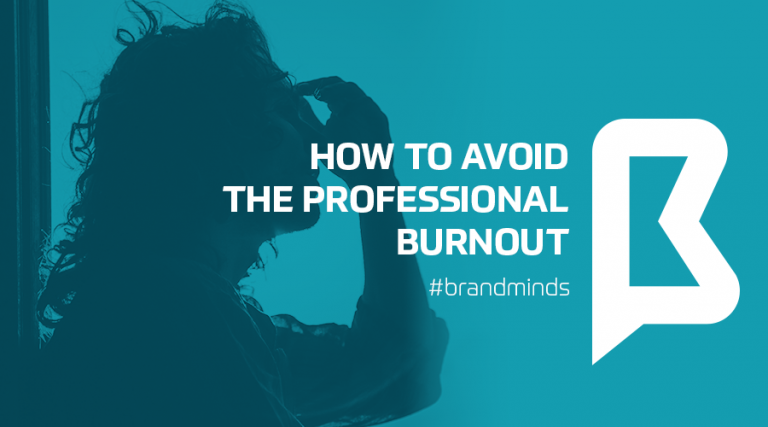
When one is passionate about their job, when one is a high-achiever, one tends to ignore the fact that they’re working exceptionally long hours, taking on exceedingly heavy workloads and putting enormous pressure on themselves to excel—all of which make them ripe for burnout.
According to psychologytoday.com, burnout is a state of chronic stress that leads to: physical and emotional exhaustion, cynicism and detachment, feelings of ineffectiveness and lack of accomplishment. In the state of full-fledged burnout, one is no longer able to function effectively on a personal or professional level. However, burnout doesn’t happen overnight, our bodies and minds do give us warnings, and if you know what to look for, you can recognize it before it’s too late. More about the stages of a burnout and its signs one can read here.

But what can we do to avoid reaching this state? According to Christina Maslach and Michael P. Leiter in their book “The Truth About Burnout: How Organizations Cause Personal Stress and What to Do About It”, when burnout occurs, three things happen: you become chronically exhausted, cynical and detached from your work and you feel increasingly ineffective on the job.
An idea would be to try and be more optimistic and make sure you don’t fall on a pessimistic slide, or, if you have the necessary means, just try a vacation. Realistically speaking though, things are not as easy as they seem, hence the problem creeping out on you and making it quite a big issue.
Pay attention to the voice in your head. When it starts describing negative events as permanent, pervasive or personal, correct yourself. By remembering the 3 P’s (permanence, pervasiveness and personal) and flipping the script, Martin Seligman, author of “Learned Optimism: How to Change Your Mind and Your Life” says you can make yourself more optimistic over time.
Increase your social activity. Spend time with friends, they will bring a balance into your life. As shown by bakadesuyo.com, when the American Medical Association surveyed top doctors to find out how they avoided burnout, one of the key things mentioned was “sharing issues with family and friends.”
Increase your self-efficiency. Paula Davis-Laack, JD, MAPP, an internationally-published writer who travels the globe as a stress and resilience expert, wrote for Psychology Today that self-efficacy is having the belief in your own ability to accomplish (and exercise control over) personally meaningful goals and tasks. People who have a stronger level of perceived self-efficacy experience less stress in challenging situations, and situations in turn become less stressful when people believe they can cope (Albert Bandura, 1989).
Have creative outlets. Burnout interferes with your ability to perform well, increases rigid thinking, and decreases your ability to think accurately, flexibly, and creatively. Even if you aren’t able to flex your creative muscles at work, having some type of creative outlet will keep you engaged and motivated.
Take care of yourself. Make sure you always put yourself first and don’t forget what is important to you and your life. Moreover, pay attention to your health and the outside-work life. Our bodies aren’t machines and one has to remember that things will still be here to be done after taking a much-needed break.
Start saying “no” from time to time. Don’t be afraid to say no. Every “yes” you say adds another thing on your plate and takes more energy away from you.
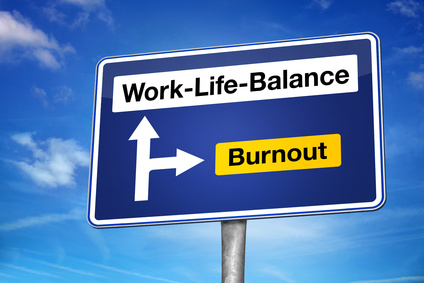
Get support where you can find it. The number of people who say they have no one with whom they can discuss important matters has nearly tripled in the past two and a half decades. The more depressed or into-work people get, the more they tend not to speak with other people or spend time with others, considering they are always under-time pressure or with a deadline hanging over their head. It’s a state one must make sure he / she doesn’t get stuck into.
According to http://99u.com, to help relieve pressure, schedule daily blocks of downtime to refuel your brain and well-being. It can be anything from meditation to a nap, a walk, or simply turning off the wifi for a while.
Concentrate on positive emotions. Studies show that increasing your diet of positive emotion builds your resilience, creativity and ability to be solution-focused, things that are in short supply if you feel like you’re burning out. I made it a point to start noticing when people did things well (and told them so), and I tried to stop being so hard on myself. Aim for a ratio of positive emotions to negative emotions of at least 3:1, which is the tipping point to start experiencing increased resilience and happiness (Fredrickson, 2009).
Limit your contact with negative people. Hanging out with negative-minded people who do nothing but complain will only drag down your mood and outlook. If you have to work with a negative person, try to limit the amount of time you have to spend together.
Make friends at work. Having strong ties in the workplace can help reduce monotony and counter the effects of burnout. Having friends to chat and joke with during the day can help relieve stress from an unfulfilling or demanding job, improve your job performance, or simply get you through a rough day.
Take time off. If burnout seems inevitable, try to take a complete break from work. Go on vacation, use up your sick days, ask for a temporary leave-of-absence—anything to remove yourself from the situation. Use the time away to recharge your batteries and pursue other burnout recovery steps. Entrepreneurs or freelancers can be especially prone to burnout. Joel Runyon plays “workstation popcorn,” in which he groups tasks by location and then switches, in order to keep work manageable, provide himself frequent breaks, and spend his time efficiently.

Set boundaries. Don’t overextend yourself. Learn how to say “no” to requests on your time. If you find this difficult, remind yourself that saying “no” allows you to say “yes” to the things that you truly want to do.
Nourish your creative side. Creativity is a powerful antidote to burnout. Try something new, start a fun project, or resume a favorite hobby. Choose activities that have nothing to do with work.
Set aside relaxation time. Relaxation techniques such as yoga, meditation, and deep breathing activate the body’s relaxation response, a state of restfulness that is the opposite of the stress response.
Get plenty of sleep. Feeling tired can exacerbate burnout by causing you to think irrationally.
Avoid nicotine. Smoking when you’re feeling stressed may seem calming, but nicotine is a powerful stimulant, leading to higher, not lower, levels of anxiety.
15 Things you might not know about Daniel Goleman
Daniel Goleman is one of the world’s renowned psychologists. He was a speaker at BRAND MINDS 2018.
BRAND MINDS is The Central and European Business Summit taking place in Bucharest, Romania.
Daniel Goleman is an internationally known psychologist who lectures frequently to professional groups, business audiences, and on college campuses. As a science journalist Goleman reported on the brain and behavioural sciences for The New York Times for many years.
Here you can find some pieces of information you might not know about Daniel Goleman:
1.His 1995 book, Emotional Intelligence was on The New York Times bestseller list for a year-and-a-half, with more than 5,000,000 copies in print worldwide in 40 languages, and has been a best seller in many countries. Apart from his books on emotional intelligence, Goleman has written books on topics including self-deception, creativity, transparency, meditation, social and emotional learning, eco-literacy and the ecological crisis.
2. The Harvard Business Review called emotional intelligence— which discounts IQ as the sole measure of one’s abilities — “a revolutionary, paradigm-shattering idea” and chose his article “What Makes a Leader” as one of ten “must-read” articles from its pages.
3. “Emotional Intelligence” was named one of the 25 “Most Influential Business Management Books” by TIME Magazine. The Financial Times, Wall Street Journal and Accenture Insititute for Strategic Change have listed Goleman among the most influential business thinkers.
4. Goleman is a co-founder of the Collaborative for Academic, Social, and Emotional Learning (www.casel.org), originally at the Yale Child Studies Center and now at the University of Illinois at Chicago. CASEL’s mission centres on bringing evidence-based programs in emotional literacy to schools worldwide.
5. He currently co-directs the Consortium for Research on Emotional Intelligence in Organizations (www.eiconsortium.org) at Rutgers University. The consortium fosters research partnerships between academic scholars and practitioners on the role emotional intelligence plays in excellence.
6. Goleman is a board member of the Mind & Life Institute, which fosters dialogues and research collaborations among contemplative practitioners and scientists. Goleman has organized a series of intensive conversations between the Dalai Lama and scientists, which resulted in the books Healthy Emotions, and Destructive Emotions. He is currently editing a book from the most recent dialogue on ecology, interdependence, and ethics.
7. His most recent book, Leadership: The Power of Emotional Intelligence, offers an up-to-date summary of his thinking on leadership by collecting key excerpts from his books together for the first time in one volume with his articles from the Harvard Business Review. These include “What Makes a Leader? and “Leadership that Gets Results.”
8. Goleman’s other recent book, The Brain and Emotional Intelligence: New Insights gathers together recent findings from brain research and other sources on topics ranging from creativity and optimal performance, the brain-to-brain connection in leadership, and to how to enhance emotional intelligence itself.
9. His work as a science journalist has been recognized with many awards, including the Washburn Award for science journalism, a Lifetime Career Award from the American Psychological Association, and he was made a Fellow of the American Association for the Advancement of Science in recognition of his communicating science to the general public.
10. Recruited by the New York Times to cover psychology and related fields, in 1984 he began a twelve-year sojourn. He learned much about science journalism from his editors and colleagues, a talented crew on the science desk, and the Times offered remarkable access and visibility. But he found that his urge to write about ideas with impact sent him in directions that did not always fit what the Times saw as news.
11. His wife Tara and him tried to spend a good deal of their free time in meditation retreats or travelling together to places they enjoy that nourish this side of their lives. “Life’s simple pleasures—a walk on a beach, playing with grandchildren, a good conversation with a friend—have more appeal to me than professional honours or ambitions,” said Goleman.
12. According to him, vitality arises from sheer human contact, especially from loving connections. This makes the people we care about most an elixir of sorts, an ever-renewing source of energy. “The neural exchange between a grandparent and a toddler, between lovers or a satisfied couple, or among good friends, has palpable virtues…the practical lesson for us all comes down to, Nourish your social connections,” he added.
13. He is twice a Pulitzer Prize nominee. Moreover, The Wall Street Journal ranked him one of the 10 most influential business thinkers and he was named on the 2011 and 2013 Thinkers50‘s editions and a top business guru by Accenture Institute for Strategic Change. His article “ What Makes a Leader?” remains the most requested reprint in the history of Harvard Business Review.
14. Goleman’s newest book, Altered Traits: Science Reveals How Meditation Changes Your Mind, Brain and Body, is co-written with Richard Davidson and will be released September 5, 2017. Through cutting edge research, Goleman and Davidson explore how meditation and mindfulness can achieve real, positive, and lasting mental and behavioural change.
15. In addition to his numerous professional and academic achievements, Goleman stresses how important his private and personal life is to him on his personal website. “While a bio like this focuses on one’s public life, I find that over the years my private life has grown increasingly important to me, particularly as the years allow me to spend less time running around and more time just being. I find more and more that what satisfies me has little to do with how well one or another book does— although the good works I participate in continue to matter much,” he confesses.
Are you a #worldchanger?
Come to BRAND MINDS 2020!
Here are our first confirmed speakers; we will be announcing more speakers in the coming months so stay tuned!
Malcolm Gladwell, Martin Lindstrom and Michio Kaku

How to find inspiration
When being on your own passion is what drives you the most and keeps you going even when dealing with harder choices or long hours. Knowing that you are working towards a goal and making a dream come true is essential. But what does one do when is faced with a moment of lack of inspiration, where does one find it, especially when faced with a deadline? Even the more creative and inspiration people have found out that is not that easy to answer the question and even they have been faced with this problem.
Here are some of the ideas we have for you and that we know work.
Change the place that you are working from
Being “stuck” at a desk or the same environment may prove out to be a good reason for loosing inspiration or seeing things from the same angel. Going out, even for only an hour, taking out the laptop and working from the park or a nearby coffee shop with a great view may change your opinion about how you see things and help you discover a fresh view. The outdoors can do magic for new ideas.

Do sports
Breaking the work pattern with an hour of swimming or running can clear up your mind of problems and stress. The endorphins being released can help you revitalize your mind and body and also focus better in the future.
Leave your phone behind
By totally disconnecting from your daily work, you get to be again in touch with yourself and your passions and remind you what truly brought you into this path. Meeting new people, talking with friends about other subjects will open yourself to new perspectives and ideas, which will ultimately translate into inspiration.
Listen to and / or play music
Music is an eternal source of imagination and inspiration and helps you reach into your emotion and feelings. But at the same time it can help you clear up your mind and put ideas in order.
Find a quiet place
Peace can also help if you have a very stressful period of time, with many projects. Time to listen to the ideas in your “head” may be always a good thing.
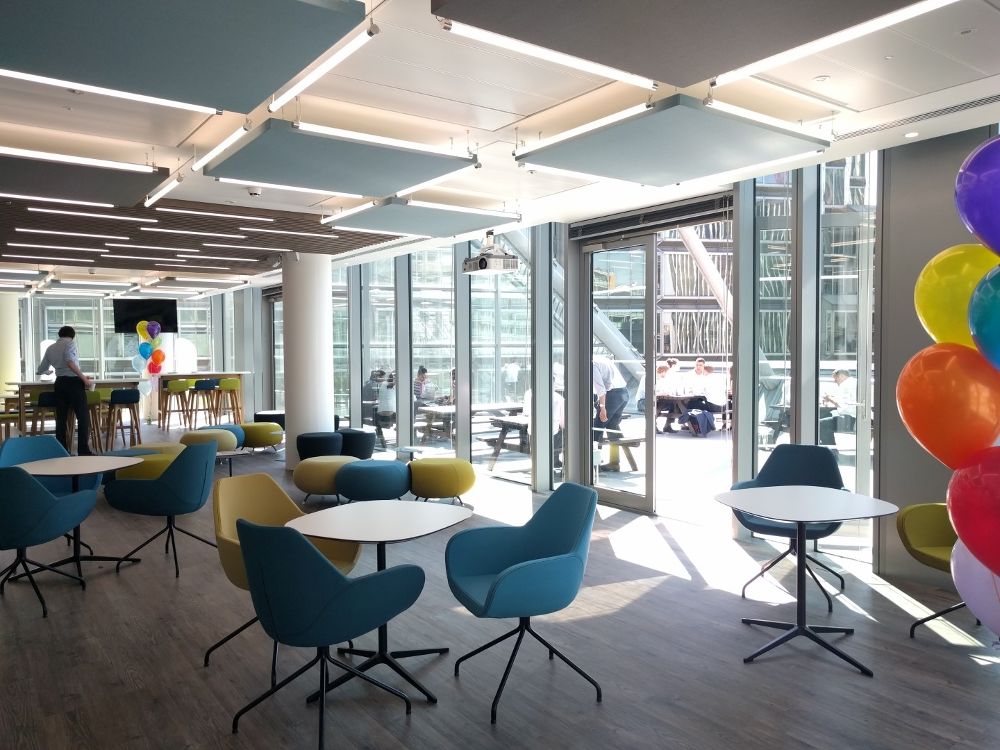
source: glassdoor.co.uk
Spend time online
Reading and looking through different news and pieces of information helps your brain remain active and ready to spark an idea that can be unique and original. Knowledge is also key to inspiration, as it creates a fertile soil for innovative ideas to emerge.
Brainstorm
Surrounded yourself by people who think differently than you and that live different lifestyles and challenge them to a brainstorming. This process will definitely offer you new perspectives and ideas that you would have never come up with on your own.

Broaden Your Horizons
Traveling is a great way to see how the rest of the world lives. You can get inspiration from seeing new ways of doing things or discovering needs you didn’t know existed.
Study History
History is full of great ideas. What’s more, it often contains the processes and the influences behind those great ideas. Tracing the creativity of great minds in the past can help you find new solutions in the present.
Simplify:
Sometimes a lack of inspiration can come from working on too many projects. Just try and focus on solving one problem at a time.
Keep Pushing:
Anyone can have one good idea. Unfortunately, you need a lot of good ideas to make a business work. The best entrepreneurs relentlessly follow up on their first idea and keep picking away at new problems for as long as it takes.


